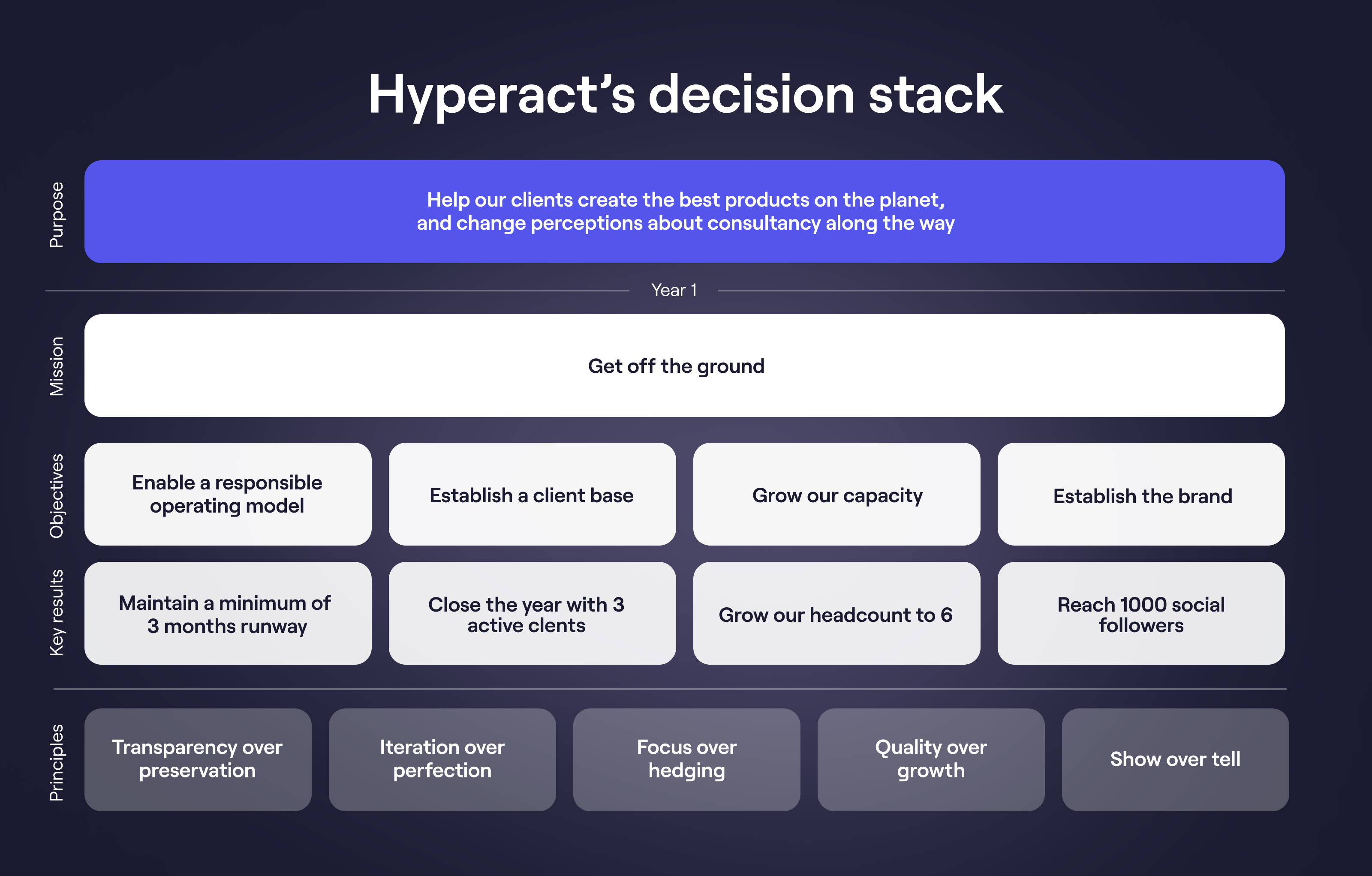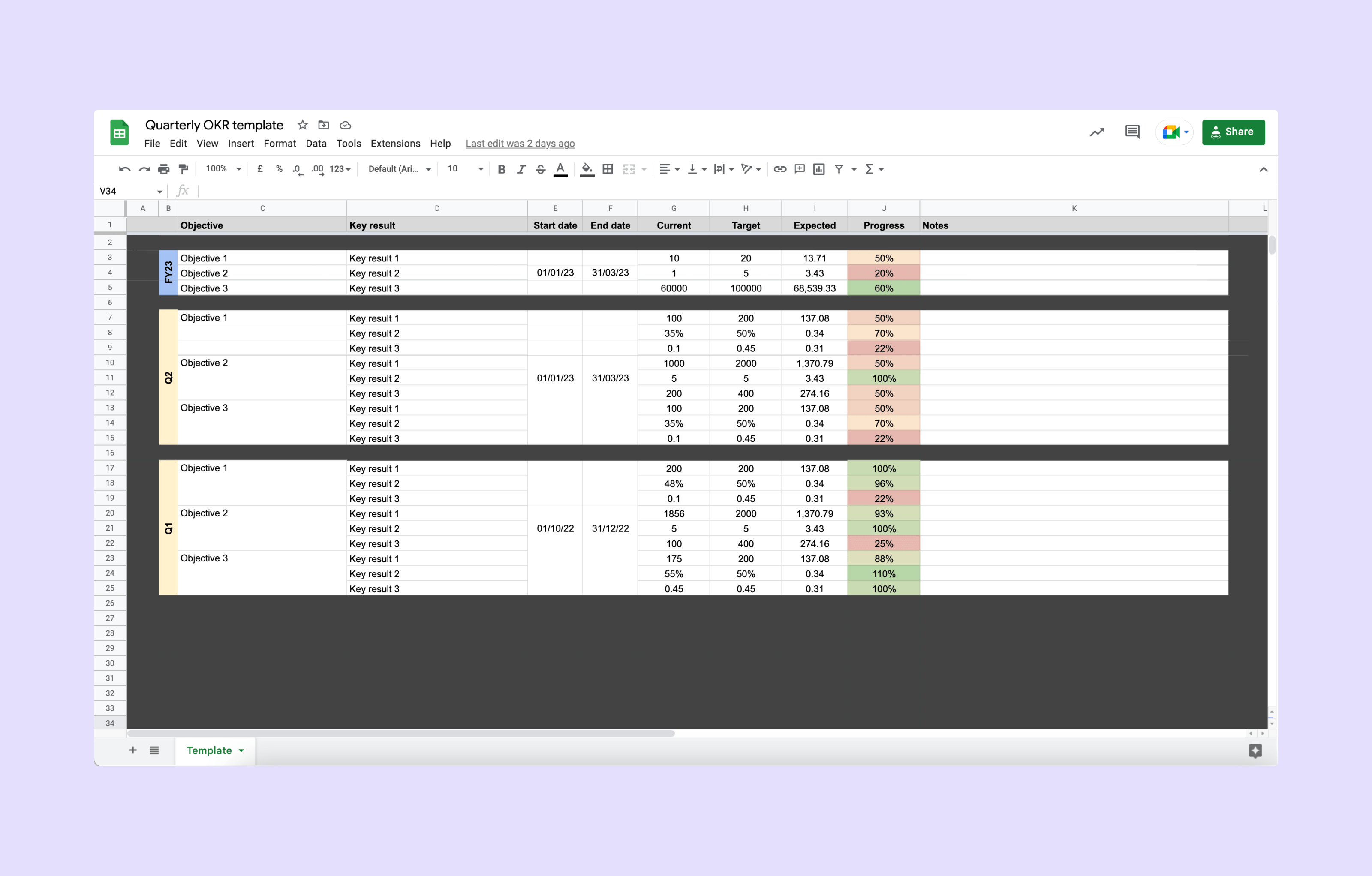Dogfooding: Hyperact’s decision stack
As businesses scale, the challenge of keeping everyone aligned becomes even more pronounced. With more people and departments involved, it's easy for priorities to shift and for individuals to lose sight of the bigger picture. But keeping everyone on the same page doesn't have to mean slowing down decision-making. When people have a clear reference point that aligns with overall business objectives, they can make faster and more confident decisions that drive the organisation forward.
The key is to provide a tool that is both concise and comprehensive, allowing people to quickly understand how their actions contribute to the company's success. Luckily, there are plenty out there – with the VMOST framework, Decision Stacks, and OKRs amongst the most popular.
While each of these frameworks offers a slightly different solution, fundamentally they show how high-level goals cascade down into action. They present a clear structure for shaping each level of decision – understanding the “why” from the bottom up and the “how” from the top down, creating both alignment and empowerment. Their popularity is owed to their simplicity. So while they can often sit in front of, or alongside a more detailed plan, they serve as the one artefact that distils this thinking into a format that people can remember.
Having spent a lot of time helping other businesses define and distil their corporate or product strategy we thought it was high time we shared our own decision stack, which borrows concepts from these popular frameworks (an approach we encourage our clients to take as well, instead of slavishly aligning to any particular framework).

How we structure our decision stack
Purpose
Controversially, the top of our decision stack is ‘purpose’, not ‘vision’. When we set up Hyperact there wasn’t a grand version of the future that we wanted to create. We thought long and hard about ‘being #1’ etc. but none of it felt genuine, unique, or particularly inspirational. Our purpose is to create value for our clients, by creating great experiences for their users, and what gets us out of bed in the morning is doing the best job we can for them.
Mission
We set our missions on a 12-18 month time horizon. Our missions are a measurable increment towards enabling our higher purpose. They answer the question ‘what are we doing to fulfil our purpose?’. As a start-up, our focus in our first year is simply to ‘get off the ground’. Start the wheels of growth in motion. Survive. Learn.
Objectives
These are the main goals or outcomes that we feel will help us achieve our mission. The key here is to not have too many, as this can lead to a lack of focus and dilute our efforts and resources. It's important to prioritise and focus on the most important objectives that will have the greatest impact on achieving our mission. A good rule of thumb is to have no more than three to five objectives at any given time, each with specific, measurable targets or key results that will help us track our progress and stay on course towards our goals.
Key results
Each of our four main objectives has a corresponding key result. These are not the only key results we use to measure our progress towards these objectives, but they are the main ones we care about. We use more granular key results as part of our quarterly OKR process. You can find our Google Sheet OKR template here.

Principles
The principles at the bottom of our decision stack refer to the foundational values and beliefs that guide our day-to-day decision-making. They help crystallise the inherent trade-offs needed in any good strategy.
And that’s it. It fits on half a page (depending on your font size). It takes less than a couple of minutes to talk through or read. No hour-long all-hands needed.
Crucially, everything we do for Hyperact should align with this. We have key results for each objective that we talk through in a regular catch-up once a month. We visualise our work in progress. We tie our most granular tasks to the relevant objective(s). We hold ourselves and each other to account on this every single day if we think anyone is doing anything that isn’t working towards the above.
Decision stack traps we're keen to avoid
🤐 Not getting feedback - Too often, these types of artefacts or company strategy decks land from 40,000 feet, probably in an all-hands where you’ve been muted. Why is this? What a missed opportunity to a) improve it, b) motivate people, and c) align
🌐 Making it too generic
🔬 Making it too specific
🤯 Making it too convoluted
😴 Making it dull. Disengaging. Demotivating. A drag on time
🏟️ Not making it ambitious enough
🙈 Hiding it away from the world
💭 Not explaining where it came from / how it was pulled together
🌱 Not explaining how it will evolve (and it will evolve - trust us)
Feedback
Let us know what you think. If you came to work for us, would these inspire you? What would your OKRs be? How could the org OKRs be adapted to better align with yours?
Similarly, we would love to hear about your organisation. Do you use Decision Stacks, VMOSTs, OKRs, or something similar? How are they working for you? How do they relate to your day-to-day?
Email: hello@hyperact.co.uk

